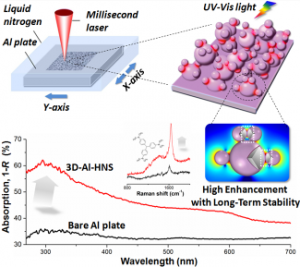Plasmon is a type of vibration produced by interactions among free electrons and photons on the surface of metals in an electromagnetic field. Nano plasmonic materials produce plasmonic resonance on certain areas of the surface during the light-harvesting progress, generating a strong electric field, therefore it has a wide range of prospective applications in the fields of solar energy utilization, spectral sensors and so on.

Within a moderate distance, a strong electric field is generated between two metal nanoparticles. The enhanced area of the electric field is called the hot spot. Hot spot can greatly promote the sensitivity of a spectral sensor, so facilitating efficiency in solar-to-chemical or solar-to-electrical energy conversion. Therefore, the key point of forming a hot spot is to form the moderate distance between two metal nanoparticles.
A team led by Professor Yang Jing of Tianjin University, exploited a convenient and efficient millisecond-laser-direct-writing in liquid nitrogen (MLDW-LN) technology, which can fabricate 3D aluminum hybrid nanostructures (3D-Al-HNSs) with a high density of plasmonic hot spots. The achievement was published in the Advanced Functional Material journal and was reported as a back-cover research paper. National Natural Science Foundation of China funded the research.
Traditional noble plasmonic metals are costly, and the fast oxidation of Ag degrades its stability. Aluminum (Al), as an emerging cost-effective plasmonic material, has advantages over supporting plasmon resonance across a broad-spectrum range from UV to visible light and is of great stability. However, the Al nanostructure, reported so far, were usually 2D arrays of isolated plasmonic units, lacking any plasmonic couplings between the units, and had a low level of hot spot density.
The technique exploited by team Yang uses the 3D-Al-HNSs composed of 3D-stacked hybrid assemblies of Al2O3 self-assembled on the larger NPs for each of the hybrid assemblies. The 3D-Al-HNS was directly made on the surface of a polished Al plate, with a well-designed overall shape and dimension, via the MLDW-LN strategy, where a low-power millisecond laser beam was concentrated to irradiate the plate soaked in liquid nitrogen. The production method illustrates the design of millisecond laser ablation of a metal plate soaked in liquid nitrogen. As a result, every particle in the material forms a nano-layer of Al2O3,providing moderate distance between adjacent particles by nano layers and generating strong plasmonic resonance to form a high density of hot spots. Thus, the electronic field on the surface is obviously higher than other parts. Moreover, the structure of 3D-Al-HNSs promotes a higher density of hot spots than that of the normal 2D structure. The wide-area, the high density of hot spots and the 3D-Al-HNSs nanostructure has a strong possibility of resonance from light, from UV to the visible spectrum, thus promoting the solar-to-chemical or solar-to-electrical energy conversion.
This kind of material can serve as a substrate for surface-enhanced Raman spectroscopy, detecting traces of molecules. Furthermore, the traditional plasmonic material, that is noble metals, can be used only once. However, the 3D-Al-HNSs have a duration of 6 months and can be used many times.
By: Fang Xueqing, Xu Hui, Sun Xiaofang
Editors: Yin Shiyu and Ross Colquhoun






